
by Rick O'Connor | Sep 23, 2021
These are all fish that many have heard of but know nothing about. They are not even sure what they look like. We have heard of them as a seafood product. Smoked herring, canned sardines, and anchovy pizza are popular the world over. These are one of the largest commercial species harvested in U.S. waters. In 2020 over 6 million pounds of sardines, 12 million pounds of anchovies, 41 million pounds of herring, 1.3 BILLION pounds of menhaden were harvested. The menhaden catch alone was valued at just under $200 million2. It not as large a fishery in Florida. 327,000 pounds of menhaden, 700,000 pounds of sardines, and 1.8 million pounds of herring were harvested from state waters in 2020 and at value of about $900,000 in 2020. The fish are popular in many European dishes, cat food, and menhaden oil is used in many products.
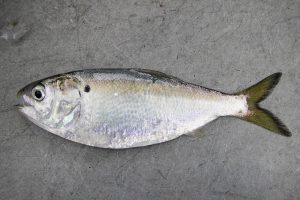
The Gulf menhaden supports a large commercial fishery in the Gulf of Mexico.
Photo: NOAA
These fishes are actually divided into two families. The herring, sardine, and menhaden are in the Family Clupeidae and are often called “clupeids”. This family includes 11 species in the northern Gulf of Mexico. Most have a “hatchet” shape to their bodies – being straight along their back with a deep curve along the ventral side, and most having a forked, or lunate, tail. They average between 2-20 inches in length and form massive schools as they travel near the surface waters filtering plankton. They are often harvested using purse seines. Large factory vessels will plow the waters searching for the large schools. Often, they will use aerial assistance to search such as small airplanes or ultralights. Once spotted, small chase boats will be launched from the factory vessel hauling the large purse seine around the school. Once that is completed a large weight called a “tommy” is dropped that “zips” the purse shut and captures the fish. There is little bycatch in this method.
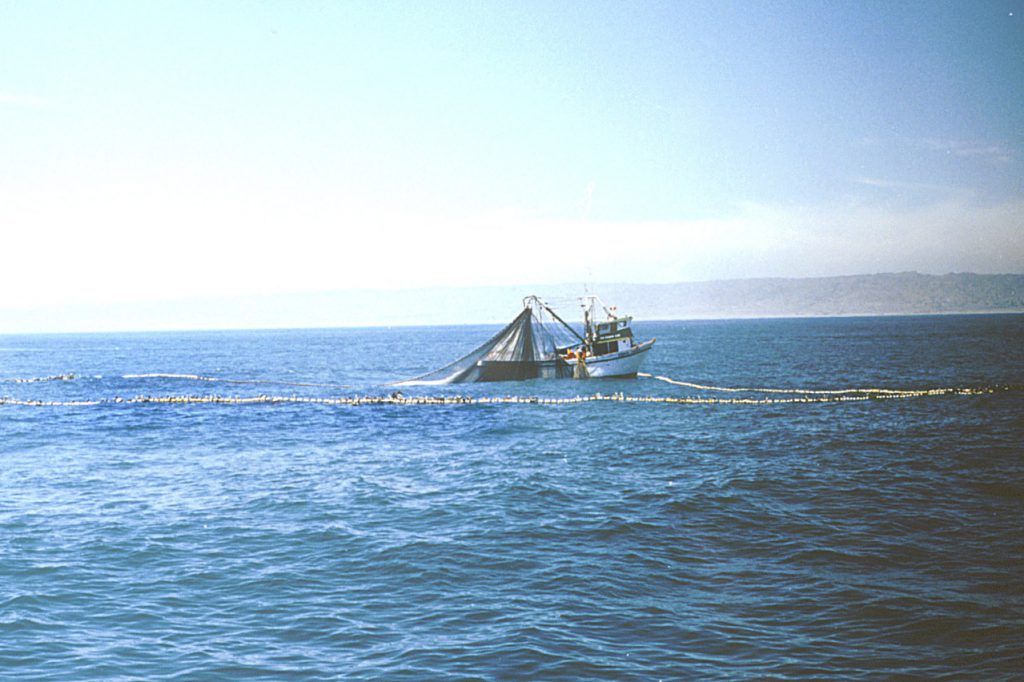
Purse seining in the Pacific Ocean.
Photo: NOAA
The anchovies are found in the family Engraulidae. They differ in that they are more streamlined in shape and their mouths are larger / body size than the clupeids. Though there is no commercial fishery for them in Florida, they comprise one of the largest groups of schooling fish in the northern Gulf of Mexico. Hoese and Moore mention that the local species are too small for a fishery. The five native species average between 2.5-5.5 inches in length1. Some marine biologists consider anchovies as an “environmental canary”, or indicator species. Their presence can suggest good water quality. I have often caught them in seines along the beach in the Pensacola area. They resemble the very common silverside minnow in that they have a silver stripe running down their sides. But they differ in that they (a) only have a single dorsal fin (silversides have two), and (b) their snouts extend to a point resembling the head of a shark.
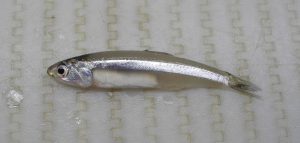
This striped anchovy resembles a silver side but differs with the shape of its snout and the number of dorsal fins.
Photo: NOAA
The distribution and biogeography of this group of fishes is all over the place. The round herring (Etrumeus teres) has few barriers and is found from the Bay of Fundy (at the Canadian/Maine border) to the Pacific Ocean1! A few species have the classic “Carolina” distribution – meaning they are found from North Carolina south, the entire Gulf of Mexico, and down to Brazil. For whatever reason (currents, water temperature, other) they do not venture north of the Carolinas and are probably impacted by the large amount of freshwater entering the Atlantic Ocean near the Amazon River.
Twp species are restricted by tropical conditions. The tiny dwarf herring (Jenkinsia lamprotaenia) and the Spanish sardine (Sardinella anchovia) are both listed as being restricted by water temperatures, though I have captured plenty of the Spanish sardines in the Pensacola area.
Some species are restricted to either the eastern or western Gulf of Mexico. Usually, the barrier for this distribution is the Mississippi River. Like the Amazon, there is a large plume of highly turbid/low salinity water extending into the Gulf of Mexico which keeps some species from crossing. Hoese and Moore report the Alabama shad (Alosa alabamae) only from the area between the Mississippi River and the Florida panhandle. The Mississippi River to one side, and the Apalachicola on the other.

Clupeids, like this Pacific sardine, for m large schools can consist of literally millions of fish.
Photo: NOAA
And finally, there is a spatial distribution with some species between freshwater, estuaries, and the open shelf. Two species, the threadfin shad (Dorosoma petenense) and the gizzard shad (Dorosoma cepedianum) are more associated with freshwater. The scaled sardine (Harengula pensacolae) is more common on the open shelf of the Gulf.
We all know the names of these fish but are unaware of their general biology and importance to commercial fisheries around the world. Many are common in our estuaries and play an important role in the health of the overall ecology. They are important members of the “panhandle fish family”.
References
1 Hoese, H.D., R.H. Moore. 1977. Fishes of the Gulf of Mexico; Texas, Louisiana, and Adjacent Waters. Texas A&M Press, College Station TX. Pp. 327.
2 NOAA Fisheries. 2021. Commercial Landings. https://www.fisheries.noaa.gov/foss/f?p=215:200:2082956461436::NO:::.
3 Florida Commercial Landings. 2021. Florida Fish and Wildlife Conservation Commission. https://myfwc.com/research/saltwater/fishstats/commercial-fisheries/landings-in-florida/.
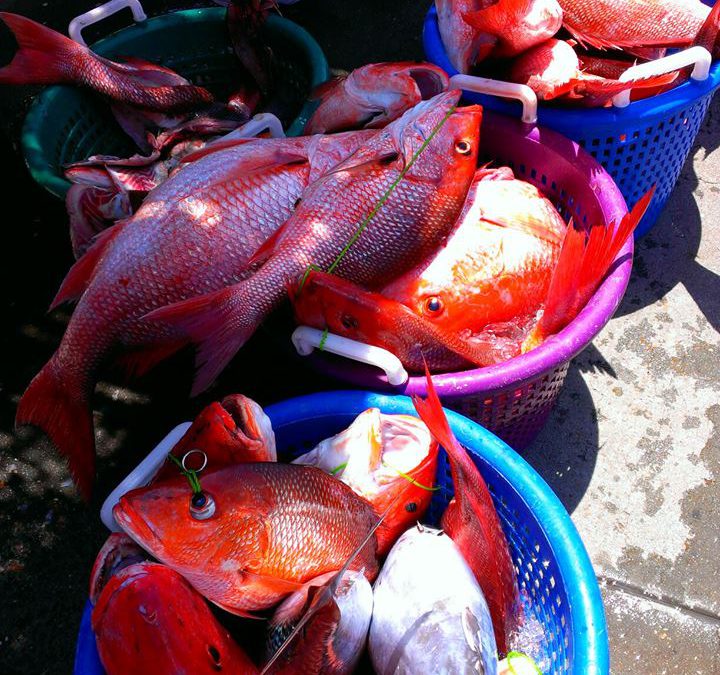
by Rick O'Connor | Aug 18, 2017
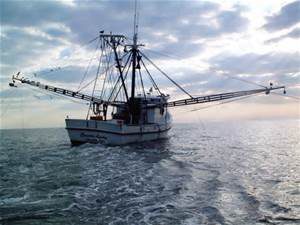
Shrimping in the Gulf of Mexico.
Photo: NOAA
Actually, if you like seafood – it’s all good! However, not everyone does and sometimes when this question is asked they are interested in not how it taste but where the seafood came from.
In recent years, there has been a move across the country to learn more about where their food comes from. Whether that is because they are concerned what the livestock and chickens have been fed, their living conditions, or whether they came outside the United States – more people are asking and it is affecting how they purchase their food. Is it the same for seafood?
In some cases, yes. Several years ago, I ran the marine science program at Washington High School. We were discussing whether, with a growing human population, the ocean could sustain the demand for seafood. Would we need to focus our production on aquaculture? We decided to survey locals to see whether (a) they liked seafood, and (b) if so, would it matter whether the product came from the ocean or a farm. Over a 10-year period, we found that (a) the percentage of locals who did not like seafood increased. (b) Those who did like seafood did not have strong feelings whether it was from a farm or from the sea. Curious as to why those who did not like seafood felt that way, we followed up with those questions and found it was not as much a concern with seafood safety in that they just did not like the taste of it. Of course, this was a high school science project and not a formal science investigation, but they did a good job with it and the results were interesting.
That was almost 20 years ago, do people feel the same? According to Dr. George Baker (Florida Sea Grant), yes… things are about the same. If they can get access to wild harvested seafood at a good price, they will buy. If it is not available, or to expensive, they will, purchase farm raised. Moreover, more people do not like seafood.
What about the local issue? In California, there is a program that allows you to find out which boat captain caught your fish. In Florida, there are studies going on to determine what type of filet you are actually buying. As with produce and livestock, people seem to be interested in where their seafood comes from – and for many, if effects where and how they buy seafood.
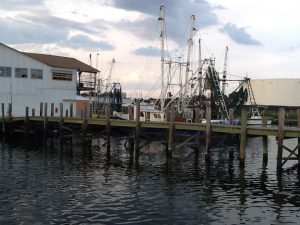
Commercial seafood in Pensacola has a long history.
Photo: Rick O’Connor
So what is local?
Well, we call any seafood product harvested or cultured within 250 miles local. For Pensacola, that would include Alabama, Mississippi, and eastern Louisiana. We know that between 80-90% of the seafood you currently purchase is imported from both commercial fishing and aquaculture overseas. That said, local seafood is still here and available.
The commercial fishing in Pensacola goes WAY back. It was one of the first industries to get off the ground shortly after Florida became a U.S. territory. According to Dr. Jack E. Davis, in his book The Gulf; The Making of an American Sea, Cuban fishermen harvested seafood from the Gulf coast of peninsula Florida prior to our becoming a territory. Shortly after becoming a U.S. territory, New England fishermen came to harvest the Gulf, including one by the name of Leonard Destin. Soon a fishing industry was operating in Pensacola. They sold a variety of species but in 1840 they found red snapper – and the boom was on. Shrimp followed but water quality, habitat loss, and overharvesting have plagued the industry over the years. Fishermen did well for a time, then the landings decreased, the fishermen believed the fish had moved, and so the fleet would move. This continued until they have literally moved all over the Gulf of Mexico seeking fish. At this point quotas had to be initiated and regulation has been the norm ever since. Add to this an increase interest in recreational fishing, increasing the number of fishermen, and increased regulation with this sector. Today we can include the introduction of invasive species as another stressor.
All that said, local seafood is still available. Some species have become quite pricey, but they are still available. The Gulf & South Atlantic Fisheries Foundation created a Gulf Coast Seafood Species Chart. This chart indicates when selected species are in peak season for commercial harvest. This chart suggests they are in season year round but there are peak months. It varies from one state to another, but the list below includes Florida and Alabama.
| Species |
Months in Peak Season |
Comments |
| Blue crab |
No peak season |
|
| Blue crab
Soft shell |
Mar – Jun |
|
| Black drum |
No peak season |
|
| Red drum |
No peak season |
Subject to quotas and closures |
| Clams |
All year – FL only |
Clams are now cultured in FL and are available year round |
| Crawfish |
Apr – Jun – LA only |
LA only, but close to us |
| Flounder |
Jul – Aug; Oct-Nov |
Subject to quotas and closures |
| Grouper |
No peak season |
Subject to quotas and closures |
| King mackerel |
Jan – Feb; Jul-Sep; Dec |
Subject to quotas and closures |
| Mahi-Mahi |
May – Jun |
|
| Mullet |
Jan; Sep – Dec |
|
| Oysters |
Jan – Apr; Sep – Dec |
|
| Pompano |
Jan – Apr; |
|
| Sheepshead |
No peak season |
|
| Brown shrimp |
May – Sep |
|
| Pink shrimp |
Jan – Jul |
|
| Rock shrimp |
Jun – Sep |
|
| White shrimp |
May – Nov |
|
| Snapper |
Peak season year round |
Subject to quotas and closures |
| Yellowtail snapper |
Mar – Jun |
|
| Spanish mackerel |
Jan – May; Aug – Sep; Dec |
Subject to quotas and closures |
| Spiny lobster |
Aug – Sep; Oct – Nov |
|
| Spotted seatrout |
No peak season |
Subject to quotas and closures |
| Stone crab |
Oct – Dec |
|
| Swordfish |
Sep – Nov |
|
| Yellowfin tuna |
Jun – Oct |
|
The health benefits from consuming seafood are understood. We certainly think it should be part of your of weekly dinner menu. There are concerns for safety in some seafood products, as in mercury and king mackerel, and we will address that in another article – but the lack of consuming seafood can create health issues as well. We hope you enjoy local Gulf seafood.
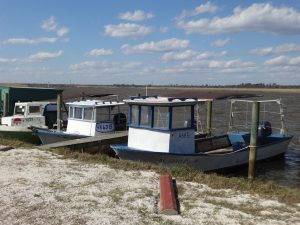
Commercial crab boats docked on Escambia Bay.
Photo: Rick O’Connor
References
Baker, G. 2017. personal communication.
Davis, J.E. 2017. The Gulf; Making of an American Sea. Liveright Publishing. New York NY. Pp. 530.
Gulf & South Atlantic Fisheries Foundation. 2013. Gulf Coast Seafood. www.eatgulfseafood.com









